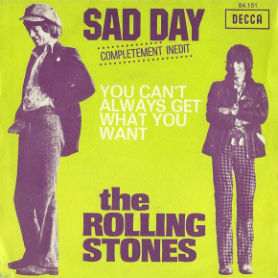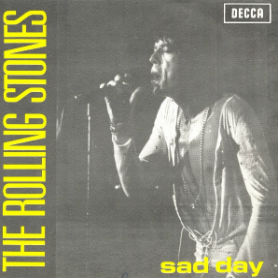Richie Unterberger confirmed my hunch in his review of Rolling Stones B-side “Sad Day” for AllMusic:
“‘Sad Day’ is one of the least-known early Rolling Stones songs. It was never even issued in their native U.K. until 1973, and it didn’t make it onto an American album until it appeared on the 1989 box set Singles Collection: The London Years.”
The song originally came to my attention due to the use of the quirky and futuristic “Rugby” typeface on a 7-inch picture sleeve released in Italy — eight years after it was recorded.
Italy – 1973
Rugby typeface
 Amusing to consider how out of place time-wise this 1965 track must’ve sounded in 1973, given pop’s explosive growth between those eight years — a particularly fertile time for popular music:
Amusing to consider how out of place time-wise this 1965 track must’ve sounded in 1973, given pop’s explosive growth between those eight years — a particularly fertile time for popular music:
“Sad Day” by The Rolling Stones (December 1965)
Musician credits (and also here)
Mick Jagger: Vocals
Keith Richards: Guitar & Vox
Brian Jones: Guitar
Bill Wyman: Bass
Charlie Watts: Drums
Ian Stewart: Organ
Jack Nitzsche: Piano & “Nitzsche-phone”
Even more amusing to note that “Sad Day” would be the A-side (!) in 1973 over “You Can’t Always Get What You Want,” not only in Italy but all of the other international markets indicated below — except Japan, for reasons that will likely never be known.
Netherlands
Sweden
France
Belgium
Germany
Denmark
Yugoslavia
Japan
Those who pay attention to detail are no doubt wondering – what, uh, is a “Nitzsche-phone”? As former Stones manager (and co-founder of the UK’s great indie label, Immediate) Andrew Loog Oldham would explain in an obituary written for Gadfly Online:
And then there was the nitzschephone, that mythical instrument! I made that up for the credits on those Stones albums—it was just a regular piano (or maybe an organ) miked differently. It was all part of this package that was created around the Stones. People believed it existed. The idea was meant to be: ‘My god, they’ve had to invent new instruments to capture this new sound they hear in their brains.’ And they were inventing fresh sounds with old toys—therefore, it deserved to be highlighted—it was the read-up of creation, of imagination—getting credit for a job well done. I mean you wouldn’t, for instance, have found a “nitzschephone” on a Freddie and the Dreamers record.
Kevin Swift chronicled this December, 1965 recording session at RCA’s Hollywood Studio in a 1966 issue of Beat Instrumental (via Ian Stewart Sixth Stone music blog):
Keith Richards and Mick Jagger acted as musical directors until the others got the gist of the numbers and then it was a free-for-all with everyone chipping in with their own particular ideas. Charlie Watts was in great form and played the bongos and conga drums like a native. He also tried his hand on a set of gigantic timpani which an orchestra had left behind. Brian Jones, Stu and American session player Jack Nitzsche took it in turns to play the harpsichord, piano or organ. Brian told me that there is a keyboard instrument on every track recorded. He and Stu handled the groovy numbers while Jack Nitzsche played on the slower tracks.
On ‘Sad Day’ and ‘Ride On Baby‘, two rather obscure tracks dating from these December 1965 sessions, Ian Stewart and Jack Nitzsche even handle the keys together. Nitzsche plays some piano on both tracks, while Stu plays piano on ‘Ride On Baby’ and organ on ‘Sad Day’, some kind of a rocked-up ballad, which ended up as the US flip-side for the band’s next single release, ’19th Nervous Breakdown.’
Greg Prevost, in 2014’s Rolling Stones Gear, would pull back the lens and reveal the carnival-like atmosphere surrounding the Stones on their musically fruitful recording expedition to Hollywood (courtesy of Rock N Roll Freaks music blog):
Tiger Beat magazine reported: ‘The normally quiet corner of Sunset and Ivar was transformed into a wild impromptu teenage street carnival for days and nights while the Rolling Stones were taping in the RCA-Victor building there.’ Visitors at the session read like a Hollywood ‘Who’s Who,’ and, to make things even more chaotic, the Monkees were recording in another RCA studio. DJ and Hollywood hipster Rodney Bingenheimer, who was attending the Monkees session, wandered into the Stones’ studio and recalled: ‘It was chaos. It was very crowded. There were a lot of kids outside, hanging around, a lot of kids everywhere. Someone brought a big white duck into the studio, and it was wandering around! Brian Wilson was there too; the Stones invited him down . . . As all this is going on, The Monkees were recording in the same studio at the same time as the Stones were recording. The Stones in one studio at RCA, The Monkees in another.’”
Many thanks to 45Cat contributor Deltics for posting this hilarious and withering review from NME (New Musical Express) in 1973:
Sad day indeed, oh my little brothers. This track dates from 1966, when it was the American B-side of ’19th Nervous Breakdown’, and apart from Jagger’s singing and a couple nice lyric touches, it doesn’t really stand out. It’s a little laid-back by current Stones standards, and presumably Brian Jones [Jack Nitzsche] is responsible for the electric piano touches. I can’t see Mick, Keith, and the lads being too happy about this resurrected oldie. The B-side is ‘You Can’t Always Get What You Want’ which was on the B-side of ‘Honky Tonk Women’. For archivists only.
Puzzled by other similarly dismissive statements made online about “Sad Day” – a song that gets better with each listen – Zero to 180 would help settle the matter by bringing in 45s historian extraordinaire, So Many Records So Little Time, to speak authoritatively on the legacy of this proud and mighty B-side:
A terribly under rated and overlooked Rolling Stones classic, ‘Sad Day’ got played as much as A side ’19th Nervous Breakdown’ in my bedroom growing up. It wasn’t even name checked on the US picture sleeve [below], and never included as part of a proper album.
 Someone at Decca UK had the seemingly good sense/terrible judgement to make it a British A side in April ’73. Huh? Must have been a featured track on one of the many, theme-less compilations Decca were shoveling out at the time.
Someone at Decca UK had the seemingly good sense/terrible judgement to make it a British A side in April ’73. Huh? Must have been a featured track on one of the many, theme-less compilations Decca were shoveling out at the time.
Corinne hates that I put my foot down recently and situated a small, 45 only, early 60′s RCA stacker on the headboard of the awesome blond Hollywood bedroom set I found at a house sale almost twenty years ago, in factory fresh condition. And ‘Sad Day’ has gotten many more plays in the past few weeks than it’s equally fantastic A side. Just for the record.
Always scour sleeves in used vinyl shops for jukebox tabs. It’s amazing the ones you will find, and the shops could care less about them. A warning though, once you start you’ll have a hard time stopping.
“Sad Day” originally backed “19th Nervous Breakdown” in 1966 for the US, Canadian, and Uruguayan markets, while in Australia, “Fortune Teller” (by the late great Allen Toussiant) would be used as the A-side instead.
Chart-wise, 45Cat contributor My Friend Jack asserts with respect to the song’s reception in the UK: “Three weeks on the Breakers list from 12 May 1973, peaking in 2nd place.”
1966 EP – Uruguay
“19.o Colapso Nervioso” + “Dia Triste” (Sad Day)
Mid-60s Stones enthusiasts should seek out classic Joe Pass 1966 album Stones Jazz — subject of an early Zero to 180 piece from 2013.














One Response
Chris, your posting on the Stones song in particular the part about the recording sessions in the RCA Victor Building triggered a musical side trip I took yesterday…
Read a cool quote yesterday in Scotty Moore’s obituary where Keith Richards said “Everyone else wanted to be Elvis. I wanted to be Scotty.” I read how pretty much only Scotty Moore and D.J. Fontana didn’t cash in on Elvis’ death and that they actually stopped playing until about 20 yrs. later. Article went on to talk about a session they then did at Levon Helm’s studio (while I read of no duck in the studio- Levon was the only performer who I ever saw have his dog wandering the stage during a show). No Brian Wilson nor the Monkeys there, but Keith Richards (and his Dad), Jeff Beck, The BoDeans, Cheap Trick, Steve Earle, Joe Ely, The Mavericks, Joe Louis Walker, Ron Wood, Rick Danko Graham Parker came through and apparently others.
I’ve had Deuce and a Quarter from the session for years but had no idea where it came from…enjoy! https://www.youtube.com/watch?v=l0jpqF1uolk
Gotta love those Keith country duets- What Kind of Fool with Jerry Lee another favorite…
Andy
Andy